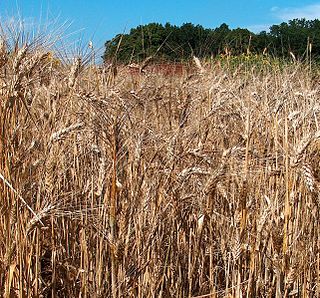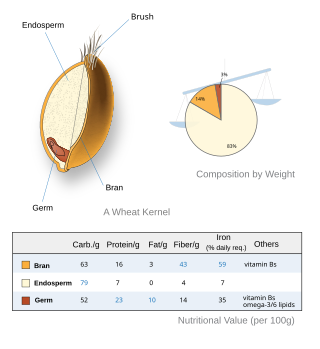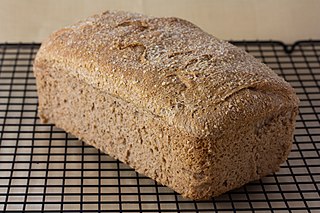
A cereal is any grass cultivated for its edible grain, which is composed of an endosperm, a germ, and a bran. Cereal grain crops are grown in greater quantities and provide more food energy worldwide than any other type of crop and are therefore staple crops. They include rice, wheat, rye, oats, barley, millet, and maize. Edible grains from other plant families, such as buckwheat, quinoa, and chia, are referred to as pseudocereals.

Gluten is a structural protein naturally found in certain cereal grains. Although "gluten" often only refers to wheat proteins, in medical literature it refers to the combination of prolamin and glutelin proteins naturally occurring in all grains that have been proven capable of triggering celiac disease. These include any species of wheat, barley, rye and some oat cultivars, as well as any cross hybrids of these grains. Gluten makes up 75–85% of the total protein in bread wheat.

Pasta is a type of food typically made from an unleavened dough of wheat flour mixed with water or eggs, and formed into sheets or other shapes, then cooked by boiling or baking. Rice flour, or legumes such as beans or lentils, are sometimes used in place of wheat flour to yield a different taste and texture, or as a gluten-free alternative. Pasta is a staple food of Italian cuisine.

Wheat is a grass widely cultivated for its seed, a cereal grain that is a worldwide staple food. The many species of wheat together make up the genus Triticum ; the most widely grown is common wheat. The archaeological record suggests that wheat was first cultivated in the regions of the Fertile Crescent around 9600 BCE. Botanically, the wheat kernel is a type of fruit called a caryopsis.

Bread is a staple food prepared from a dough of flour and water, usually by baking. Throughout recorded history and around the world, it has been an important part of many cultures' diet. It is one of the oldest human-made foods, having been of significance since the dawn of agriculture, and plays an essential role in both religious rituals and secular culture.

Rye is a grass grown extensively as a grain, a cover crop and a forage crop. It is a member of the wheat tribe (Triticeae) and is closely related to both wheat and barley. Rye grain is used for flour, bread, beer, crispbread, some whiskeys, some vodkas, and animal fodder. It can also be eaten whole, either as boiled rye berries or by being rolled, similar to rolled oats.

Flour is a powder made by grinding raw grains, roots, beans, nuts, or seeds. Flours are used to make many different foods. Cereal flour, particularly wheat flour, is the main ingredient of bread, which is a staple food for many cultures. Corn flour has been important in Mesoamerican cuisine since ancient times and remains a staple in the Americas. Rye flour is a constituent of bread in both Central Europe and Northern Europe.

Durum wheat, also called pasta wheat or macaroni wheat, is a tetraploid species of wheat. It is the second most cultivated species of wheat after common wheat, although it represents only 5% to 8% of global wheat production. It was developed by artificial selection of the domesticated emmer wheat strains formerly grown in Central Europe and the Near East around 7000 BC, which developed a naked, free-threshing form. Like emmer, durum wheat is awned. It is the predominant wheat that grows in the Middle East.

Pumpernickel is a typically dense, slightly sweet rye bread traditionally made with sourdough starter and coarsely ground rye. It is sometimes made with a combination of rye flour and whole rye grains.

White bread typically refers to breads made from wheat flour from which the bran and the germ layers have been removed from the whole wheatberry as part of the flour grinding or milling process, producing a light-colored flour.
Wheat flour is a powder made from the grinding of wheat used for human consumption. Wheat varieties are called "soft" or "weak" if gluten content is low, and are called "hard" or "strong" if they have high gluten content. Hard flour, or bread flour, is high in gluten, with 12% to 14% gluten content, and its dough has elastic toughness that holds its shape well once baked. Soft flour is comparatively low in gluten and thus results in a loaf with a finer, crumbly texture. Soft flour is usually divided into cake flour, which is the lowest in gluten, and pastry flour, which has slightly more gluten than cake flour.
Enriched flour is flour with specific nutrients returned to it that have been lost while being prepared. These restored nutrients include iron and B vitamins. Calcium may also be supplemented. The purpose of enriching flour is to replenish the nutrients in the flour to match the nutritional status of the unrefined product. This differentiates enrichment from fortification, which is the process of introducing new nutrients to a food.

A whole grain is a grain of any cereal and pseudocereal that contains the endosperm, germ, and bran, in contrast to refined grains, which retain only the endosperm.

Rye bread is a type of bread made with various proportions of flour from rye grain. It can be light or dark in color, depending on the type of flour used and the addition of coloring agents, and is typically denser than bread made from wheat flour. Compared to white bread, it is higher in fiber, darker in color, and stronger in flavor. The world's largest exporter of rye bread is Poland.
Flour bleaching agent is the agent added to fresh milled grains to whiten the flour by removing the yellow colour pigment called xanthophyll. It whitens the flour, which is used in the baking industry.
The Chorleywood bread process (CBP) is a method of efficient dough production to make yeasted bread quickly, producing a soft, fluffy loaf. Compared to traditional bread-making processes, CBP uses more yeast, added fats, chemicals, and high-speed mixing to allow the dough to be made with lower-protein wheat, and produces bread in a shorter time. It was developed by Bill Collins, George Elton and Norman Chamberlain of the British Baking Industries Research Association at Chorleywood in 1961. As of 2009, 80% of bread made in the United Kingdom used the process.

Maida is a white flour from the Indian subcontinent, made from wheat. Finely milled without any bran, refined, and bleached, it closely resembles cake flour. Maida is used extensively for making fast foods, baked goods such as pastries, bread, several varieties of sweets, and traditional flatbreads. Owing to this wide variety of uses, it is sometimes labeled and marketed as "all-purpose flour", though it is different from American all-purpose flour.

Sprouted bread is a type of bread made from whole grains that have been allowed to sprout, that is, to germinate, before being milled into flour. There are a few different types of sprouted grain bread. Some are made with additional added flour, some are made with added gluten, and some, such as Essene bread and Ezekiel bread, are made with very few additional ingredients.

Whole wheat bread or wholemeal bread is a type of bread made using flour that is partly or entirely milled from whole or almost-whole wheat grains, see whole-wheat flour and whole grain. It is one kind of brown bread. Synonyms or near-synonyms for whole-wheat bread outside the United States are whole grain bread or wholemeal bread. Some regions of the US simply called the bread wheat bread, a comparison to white bread. Some varieties of whole-wheat bread are traditionally coated with whole or cracked grains of wheat, though this is mostly decorative compared to the nutritional value of a good quality loaf itself.
Graham flour is a type of coarse-ground flour of whole wheat named after Sylvester Graham. It is similar to conventional whole-wheat flour in that both are made from the whole grain, but graham flour is ground more coarsely. It is not sifted ("bolted") with a flour dresser after milling. A report from 1913 claimed that bread made from graham flour had a protein content of 12.1% – only slightly less than white wheat flour and essentially the same as whole wheat flour.














